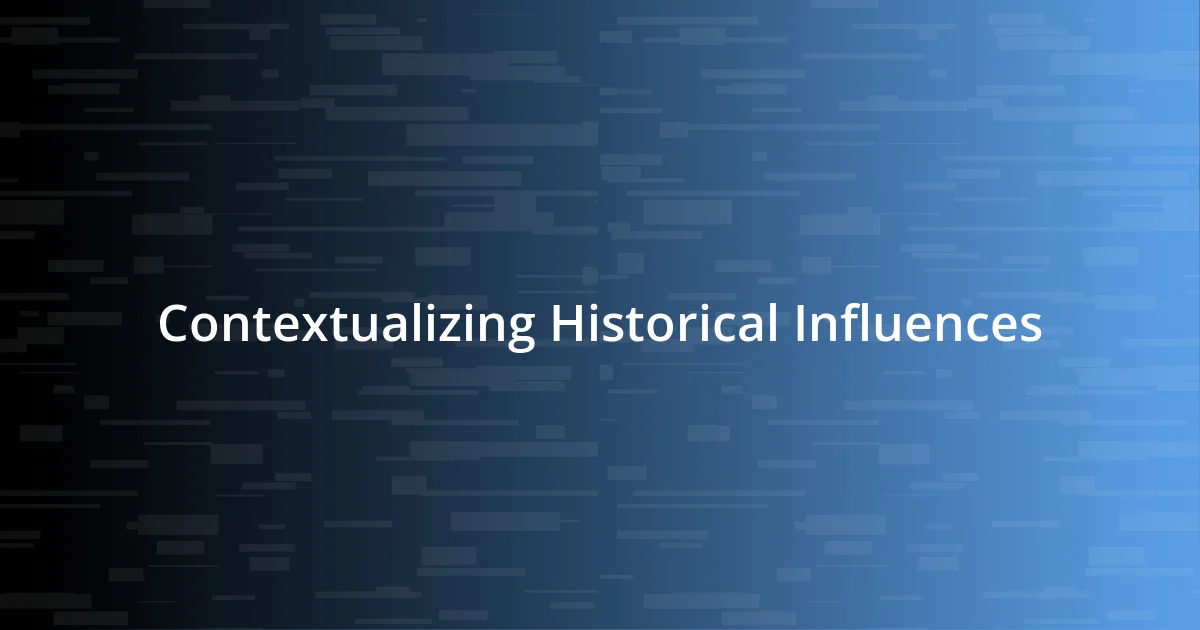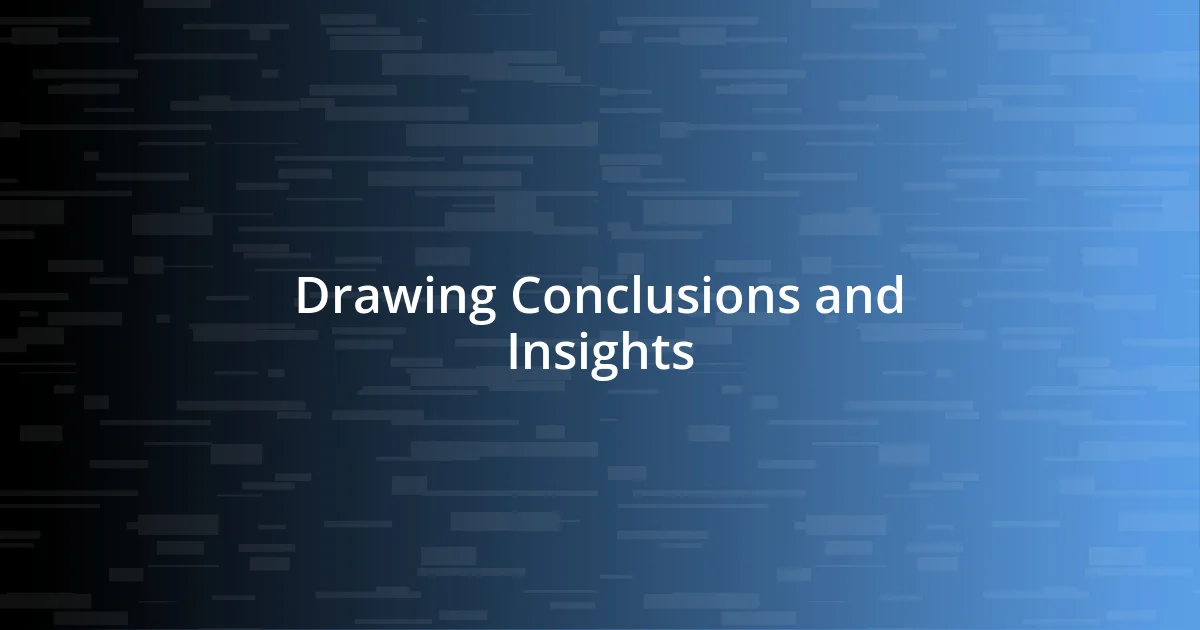Key takeaways:
- Comparative Film Studies encourages viewers to explore films as cultural narratives, fostering empathy and challenging personal biases through diverse storytelling approaches.
- Analyzing key film elements, such as narrative structure and cinematography, reveals how artistic choices convey different emotional responses and shape audience perceptions across cultures.
- Historical and cultural contexts significantly influence filmmaking, highlighting themes of identity and shared human experiences that connect audiences globally.

Understanding Comparative Film Studies
When I first delved into Comparative Film Studies, I was struck by how it invites viewers to dissect films not just as standalone entities, but as pieces of a larger cultural and cinematic puzzle. Why do certain themes resonate across different cultures? This question propelled my exploration and highlighted the diverse ways storytelling can bridge gaps between societies. For instance, examining the portrayal of love in Indian cinema versus Western films revealed profound cultural variances that prompted me to rethink universal narratives.
One compelling aspect I cherish about Comparative Film Studies is its ability to foster empathy. It encourages us to see the world through myriad lenses. I recall watching a Romanian film right after a Hollywood romance, and the stark contrast in emotional expressions left me reflecting on my own cultural biases. The rawness in the Romanian storytelling made me question the polished version of love often presented in mainstream cinema. Isn’t it fascinating how film can almost serve as a mirror, reflecting our values while challenging us to reconsider them?
As I engaged more deeply with this field, I realized that the connections between films can be surprisingly intricate. There are historical, political, and social threads that weave through varying narratives. Take, for example, the depiction of war in films from different countries. It’s not merely about the action but about how these portrayals shape national identities and collective memories. By comparing these representations, I discovered layers of meaning that enriched my understanding. Isn’t it exciting to think about how a single film can open up conversations about identity, heritage, and even personal beliefs?

Identifying Key Film Elements
Identifying the key elements in films is essential for meaningful comparisons. I often start by looking closely at aspects like narrative structure, cinematography, sound design, and character development. For instance, I once analyzed two films that explored societal injustices—one from Brazil and another from the United States. The contrasting use of lighting and sound in these films illuminated different emotional responses, which prompted me to consider how regional contexts inform artistic choices.
Cinematography can convey powerful emotions and themes, often in ways that dialogue cannot. In a recent project, I examined a German film that utilized stark black-and-white visuals. It felt like a direct emotional punch compared to a vibrant, colorful film from India that celebrated life. The starkness in the German film forced me to confront uncomfortable truths, whereas the Indian film was an embrace of joy amidst struggle. It’s incredible how visual storytelling shapes our interpretation of thematic content.
When I create comparison tables, I find them particularly useful for clarifying these dimensions. Here’s a simple comparison table focusing on how different films handle key elements:
| Film Element | Brazilian Film | American Film |
|---|---|---|
| Narrative Structure | Non-linear | Linear |
| Cinematography | Bright, colorful | Dark, muted |
| Sound Design | Diegetic sounds enriched | Emphasized score |
| Character Development | Complex, nuanced | Clear arcs |

Analyzing Cultural Contexts
Analyzing cultural contexts in film offers a gateway to understanding how societal beliefs shape storytelling. I’ve often found that the nuances in a film’s cultural backdrop can profoundly alter its message and reception. For example, when I explored a Chinese film that tackled themes of family duty, the subtleties of Confucian values made me see familial relationships differently. It opened my eyes to the diversity of obligations portrayed in cinema worldwide, encouraging deeper reflection on my own cultural expectations.
Here are some vital aspects I focus on when analyzing cultural contexts in films:
- Historical Background: Examining the time period and historical events influencing the film’s narrative.
- Cultural Norms and Values: Identifying societal lessons or morals conveyed through characters and story arcs.
- Symbolism: Understanding local symbols or traditions that may not translate well but carry significant weight within the culture.
- Audience Reception: Considering how audiences from different backgrounds perceive the film based on their own experiences.
Each of these elements unveils layers of meaning that challenge my perspective and enrich my appreciation for global cinema.

Comparing Narrative Structures
When I dive into comparing narrative structures, I often look at the pacing and timeline of each film. For example, I remember analyzing a film from Korea that employed a reverse chronology. It completely flipped my expectations as I watched the story unfold backward, which made me question how suspense is crafted. How does this unique structure change our emotional investment in the characters?
I also find it fascinating to contrast how different cultural contexts shape the narrative flow. In one project, I compared a traditional Western story arc with a circular narrative typical in Indigenous films. I noticed that the latter gave me a deeper sense of completion, emphasizing themes of connection and continuity. It led me to reflect on my understanding of storytelling and how varied approaches can evoke different emotional responses.
Finally, I often discuss the role of flexibility within narrative structures during my analyses. I recall a time when I looked at two films that shared a common theme but approached it through completely different timelines—one was episodic, while the other followed a straight path. Seeing these distinct paths helped me appreciate how filmmakers can skillfully manipulate time to enhance emotional depth. Such comparisons not only enrich my understanding but also reveal the multitude of ways stories can resonate with audiences.

Evaluating Cinematic Techniques
Evaluating cinematic techniques is essential for uncovering how filmmakers convey meaning. I often feel that the visual language of a film—like cinematography and editing—can hugely impact how a story unfolds. I remember watching a French film that utilized long takes to foster intimacy, allowing me to breathe with the characters in a way that made their struggles more palpable. Have you ever noticed how much a film’s pacing can change your emotional experience?
Lighting choices are another technique that I love to analyze. I once compared two films, one bright and airy while the other was shrouded in shadows, and it was striking to see how each choice influenced the mood. The dim lighting in a noir film, for instance, evokes a sense of danger and mystery, while the sun-soaked scenes of a romantic comedy invite warmth and joy. This contrast made me ponder how visual elements can shape not just the atmosphere but also the audience’s emotional reactions.
Sound design also plays a crucial role in setting the tone. I vividly remember watching a horror film where every creak and whisper heightened my sense of dread. The intentional use of silence punctuated moments of tension, making the eventual sound almost unbearable. Have you ever felt your pulse quicken just by the way sound envelops you in a scene? This awareness of how sound interacts with the visuals is something I enjoy dissecting, as it reveals how deeply intertwined these techniques are in creating a cohesive cinematic experience.

Contextualizing Historical Influences
When I consider the historical influences on film, I often find myself reflecting on how context shapes narratives. For instance, I vividly recall watching an Italian Neorealist film and being struck by its raw, unfiltered portrayal of post-war life. It made me question how the socio-political climate of the time can mold cinematic stories, particularly when filmmakers strive for authenticity in depicting human struggles. Isn’t it fascinating how history can seep into the framework of storytelling?
Another instance that stands out is my exploration of the Hollywood studio system during the Golden Age. I remember comparing a classic musical with a gritty film noir from the same period. The contrast was startling—while one burst with Technicolor vibrancy and escapism, the other steeped in shadows and moral ambiguity reflected the anxieties of a nation grappling with change. It led me to ponder how economic conditions and audience expectations can dictate film styles and themes.
Furthermore, national cinema often tells a compelling story about identity and culture through its historical lens. I once delved into South American films, examining how directors addressed issues like colonialism and political unrest. The powerful imagery and evocative narratives made me feel a deep connection to the struggles portrayed. In moments like this, I can’t help but ask: how do these historical contexts resonate with our contemporary experiences, bridging gaps between past and present? This exploration not only enhances my understanding but also enriches the broader conversation about the impact of history on film.

Drawing Conclusions and Insights
Drawing conclusions from my comparative analysis often feels like piecing together a puzzle. While watching a documentary side-by-side with a fictional retelling of the same event, I was struck by how each medium interpreted the underlying truths differently. It made me question: How do storytelling choices alter our perception of reality? In those moments, the documentary felt raw and authentic, while the film delivered an emotional punch through its dramatization. This contrast solidified my understanding of the filmmaker’s intent and the audience’s engagement.
I’ve also noticed that the conclusions I draw often lead to deeper inquiries about thematic elements. For instance, when I compared two films tackling love and loss, one presented a hopeful narrative, while the other explored despair. This disparity led me to think about how cultural perspectives can shape storytelling. Have you ever felt that certain themes resonate differently, depending on your personal experiences? That realization has encouraged me to explore my emotional responses and challenge my biases while critiquing various films.
Lastly, synthesizing insights from multiple films frequently uncovers universal truths. I recall a phase where I watched a series of coming-of-age stories spanning different cultures. The shared experiences of identity, belonging, and transformation made me realize how interconnected we are despite our diverse backgrounds. It’s invigorating to draw parallels and recognize that film can serve as a powerful vehicle for empathy and understanding—how can we not be reminded of our own journeys through these narratives? This not only enriches my view of cinema but also highlights its role in fostering conversations about shared human experiences.














